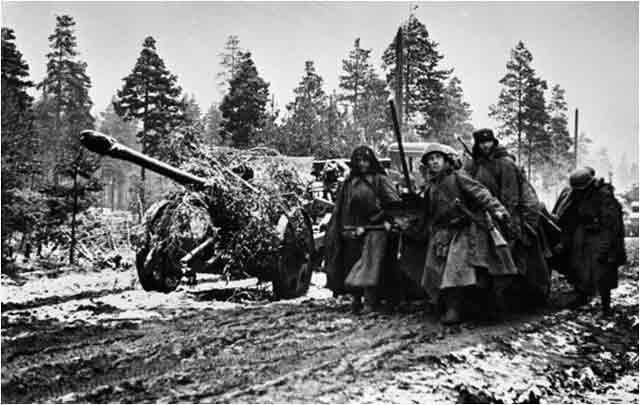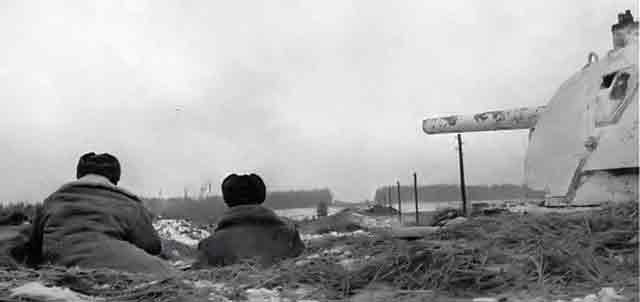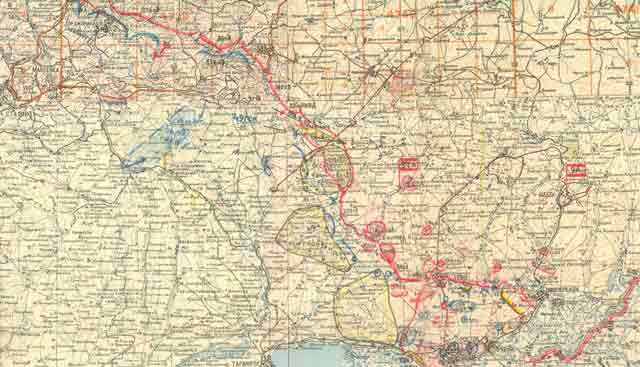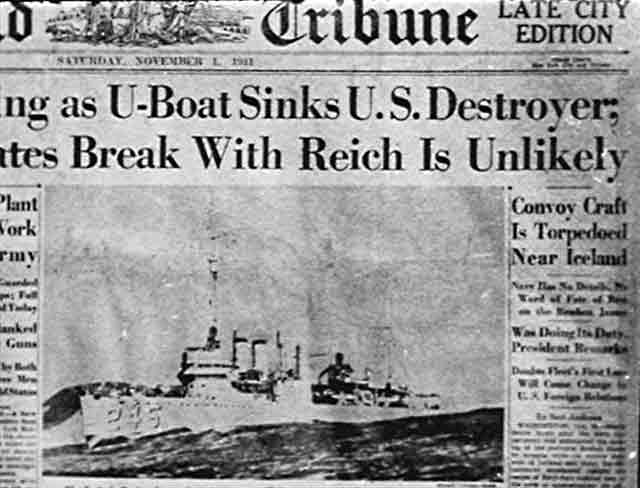Saturday 1 November 1941
 |
| Soviet field guns and troops near Leningrad, Russia, 1 Nov 1941 (Russian International News Agency). |
Eastern Front: At 06:00 on
1 November 1941, German and Finnish artillery open fire on the front west of Loukhi. Shortly thereafter, a major Axis attack commences. The Axis objective in this sector has been to cut the Murmansk railway line and thus isolate further the Soviet Union from its western allies. Despite some promising gains toward Loukhi in August, this sector has been dormant since 23 August 1941, when Finnish Major General Hjalmar Siilasvuo halted his attack due to increased Soviet resistance.
 |
| Soviet troops near Zvenigorod, Russia (about 60 km due west of Moscow), 1 November 1941 (Credit: RIAN Alexander Kapustyanskiy). It is common to think that only the Germans disliked the cold, but the Soviets had to endure it as well. |
The situation in November is different than it had been in August, however. For one thing, the Red Army has had over two months to reinforce its troops and build fortifications. In the typically convoluted command arrangements that Germany always creates with its allies, the Axis forces are under the command of both Finnish and German commanders, with the Finnish commanders having operational control and the German ones strategic - at least theoretically. The reality in such situations, though, is somewhat different than the diagram of command arrangements. For instance, in North Africa, General Rommel has primarily Wehrmacht forces, so he basically ignores his Italian "minder." On the Finnish Front, the forces are primarily Finnish - both in numbers and quality - so, the local commander is Finnish and he basically has control. In practice, this means that Maj. Gen. Hjalmar Siilasvuo’s Finnish III Army Corps, which technically is subordinated to Gen. Falkenhorst’s German Gebirgsarmee Norwegen, has control. The Axis forces include the SS Division Nord, meaning that this is the only time during World War II when an SS division fights under foreign (non-German) command.
 |
| T-34 tank and its crew prepare to ambush Wehrmacht troops on the Volokolamskoye highway northwest of Moscow, 1 November 1941. |
Another difference is the weather. This temperature when this attack opens is minus 4 degrees Fahrenheit. This is one situation when winter weather actually favors the Axis troops, as the Finnish troops proved during the 1939-40 Winter War that they operate better in extreme cold than do the Soviet troops (or German troops, for that matter). Thus, opening this offensive as winter starts to bite has some advantages from the Wehrmacht perspective.
 |
| Situation map of the Army Group South sector in November 1941, with the main battle being over Rostov-on-Don at the head of the Sea of Azov. |
The Finns have proven to be experts at "motti" tactics in the marshy and forested terrain, so having them in command makes sense to everyone. There is one problem, however, which is that the Finns have proven unwilling to pursue the objectives that the Germans want. For instance, the Finns have refused to attack Leningrad from the north despite the Wehrmacht asking them to do so. In addition, they have refused to advance beyond the Svir River into territory that historically has been Russian. The Finns view themselves as co-belligerents, not allies, which makes cooperation tricky at times. Thus, having the Finns in operational control also means that they can stop their attacks when the Germans think they should continue. In short, the Germans have mounting suspicions about the Finnish desire to do more than simply occupy lost territory and defeat the Red Army. This making having Finnish commanders deciding the course of operations problematic for Falkenhorst.
 |
| It is a Saturday in November, which in the United States means college football. It looks like someone used this ticket to the big Michigan vs. Illinois game in Illinois Memorial Stadium on 1 November 1941. |
On 1 November 1941, however, everything goes well for German-Finnish cooperation. General Siilasvuo sends the SS Division Nord on a sweeping hook to the left while two Finnish Divisions (Group J and Group F) attack directly. The Finns use their proven tactics of infiltrating the Soviet lines, while the SS men only have to manage not to get lost in the woods while trying the outflank the entire Soviet defensive line. Everything goes well during the first day, and the SS division advances an impressive five miles before running into another Soviet defensive line. The Soviets take heavy casualties and the Axis troops take many hundreds of prisoners. Two Soviet regiments are quickly surrounded and eventually eliminated. Things suddenly look better for the Axis in the far north, but actually getting to the Murmansk railroad remains to be achieved.
 |
| Sefton Delmer broadcasting to Germany from the BBC, 1 November 1941. Relations between the United States and the Reich at this time are rapidly changing from a propaganda war to a shooting war. |
US/German Relations: Relations between the United States and the Reich are extremely murky right now. President Roosevelt has committed the United States to full opposition to Adolf Hitler and Germany short of actually sending troops to Europe, while Hitler already has been counseled by Admiral Raeder, commander of the Kriegsmarine, that "There is no longer any difference between British and American ships." The sinking of the USS destroyer Reuben James by U-552 on 31 October 1941 has thrown those relations even closer to open warfare, which obviously is already is the case on the North Atlantic convoy routes. However, at least technically, the two powers are not at war.
 |
| Uncanny Tales, November 1941 (Melvin R. Colby, Editor, cover by Wilf Long). |
Hitler follows events overseas with great interest throughout the war. His cronies often see him with foreign newspapers - how much he understands the English language is an open question. He learns quickly about the sinking of the Reuben James, perhaps from his intelligence services as it is unlikely that the U-boat which sank the Reuben James could have known its identity and reported it. Knowing that this inevitably will result in another flurry of words from Roosevelt and no doubt some more illegal US Navy activities (as he sees it), Hitler preempts the US president by issuing his own statement on the matter. It claims that the United States "has attacked the Reich" and that the world's "tribunal" is judging Roosevelt. Regarding the sinking of the Reuben James, he claims that it was justified because the destroyer attacked the U-boat.
 |
| "Men of the Straits Settlement Volunteer Force in training, November 1941." These are men of Malaya Force north of Singapore. © IWM (FE 211). |
The Reuben James indeed is on Roosevelt's mind. As his wife Eleanor writes today:
The news of the torpedoing of one of our destroyers off Iceland was the first thing that the President spoke of this morning, and that has cast a shadow over the whole day. I cannot help but think of every one of the 120 men and their families, who are anxiously awaiting news.
Roosevelt acts later in the day. He signs an executive order reassigning the US Coast Guard from the Treasury Department to the Navy so that might be used in the burgeoning sea war. He also urges Congress to further amend the Neutrality Acts of the 1930s to allow the arming of U.S. merchant vessels so that they can defend themselves in war zones.
 |
| A typical newspaper headline of 1 November 1941, emphasizing that "Break with Reich is Unlikely" following the sinking of the USS Reuben James by U-552. |
The legalities of the situation are confused, and some favor the Reich. It has been traditional for active combatants to establish a reasonable zone in which neutrals are warned they enter at their own peril. For instance, during World War I a U-boat sank the Lusitania and that was accepted by the United States as a natural consequence of entering a war zone. The US Navy is actively escorting freighters on the convoy routes and attacking U-boats upon detection, which is distinctly unfriendly conduct and at least arguably an act of war in itself. On the other hand, the United States believes that the freedom of the seas is paramount and its navy and other vessels are permitted to keep its sea lanes open. These ambiguities, along with very mixed American public opinion about getting involved in another overseas war, keep FDR from actually declaring war. However, the distinction between being at war and at peace is being corroded in the process.
 |
| Moonrise over Hernandez, New Mexico. Taken looking over the Sangre de Christo mountains on 1 November 1941 by Ansel Adams. |
October 1941
October 1, 1941: Germans and Finns Advance in USSR
October 2, 1941: Operation Typhoon Broadens
October 3, 1941: Air Battles Near Moscow
October 4, 1941: Stalin Contemplates Defeat
October 5, 1941: Hoth Goes South
October 6, 1941: First Snowfall After Dark
October 7, 1941: Stalin Gets Religion
October 8, 1941: FDR Promises Stalin Aid
October 9, 1941: FDR Orders Atomic Bomb Research
October 10, 1941: Reichenau's Severity Order
October 11, 1941: Tank Panic in Moscow
October 12, 1941: Spanish Blue Division at the Front
October 13, 1941: Attack on Moscow
October 14, 1941: Germans Take Kalinin
October 15, 1941: Soviets Evacuate Odessa
October 16, 1941: Romanians Occupy Odessa
October 17, 1941: U-568 Torpedoes USS Kearny
October 18, 1941: Tojo Takes Tokyo
October 19, 1941: Germans Take Mozhaysk
October 20, 1941: Germans Attack Toward Tikhvin
October 21, 1941: Rasputitsa Hits Russia
October 22, 1941: Germans Into Moscow's Second Defensive Line
October 23, 1941: The Odessa Massacre
October 24, 1941: Guderian's Desperate Drive North
October 25, 1941: FDR Warns Hitler About Massacres
October 26, 1941: Guderian Drives Toward Tula
October 27, 1941: Manstein Busts Loose
October 28, 1941: Soviet Executions
October 29, 1941: Guderian Reaches Tula
October 30, 1941: Guderian Stopped at Tula
October 31, 1941: USS Reuben James Sunk
November 1941
November 1, 1941: Finns Attack Toward Murmansk Railway
November 2, 1941: Manstein Isolates Sevastopol
November 3, 1941: Japan Prepares to Attack
November 4, 1941: German Advances in the South
November 5, 1941: Last Peace Effort By Japan
November 6, 1941: Stalin Casts Blame in an Unexpected Direction
November 7, 1941: Stalin's Big Parade
November 8, 1941: Germans Take Tikhvin
November 9, 1941: Duisburg Convoy Destruction
November 10, 1941: Manstein Attacks Sevastopol
November 11, 1941: Finland's Double Game Erupts
November 12, 1941: T-34 Tanks Take Charge
November 13, 1941: German Orsha Conference
November 14, 1941: German Supply Network Breaking Down
November 15, 1941: Operation Typhoon Resumes
November 16, 1941: Manstein Captures Kerch
November 17, 1941: Finland Halts Operations
November 18, 1941: British Operation Crusader
November 19, 1941: Sydney vs. Kormoran Duel
November 20, 1941: The US Rejects Final Japanese Demand
November 21, 1941: Germans Take Rostov
November 22, 1941: Kleist in Trouble at Rostov
November 23, 1941: Germans Take Klin, Huge Battle in North Africa
November 24, 1941: Rommel Counterattacks
November 25, 1941: HMS Barham Sunk
November 26, 1941: Japanese Fleet Sails
November 27, 1941: British Relieve Tobruk
November 28, 1941: Rostov Evacuated, German Closest Approach to Moscow
November 29, 1941: Hitler Furious About Retreat
November 30, 1941: Japan Sets the Date for its Attack
2020










No comments:
Post a Comment